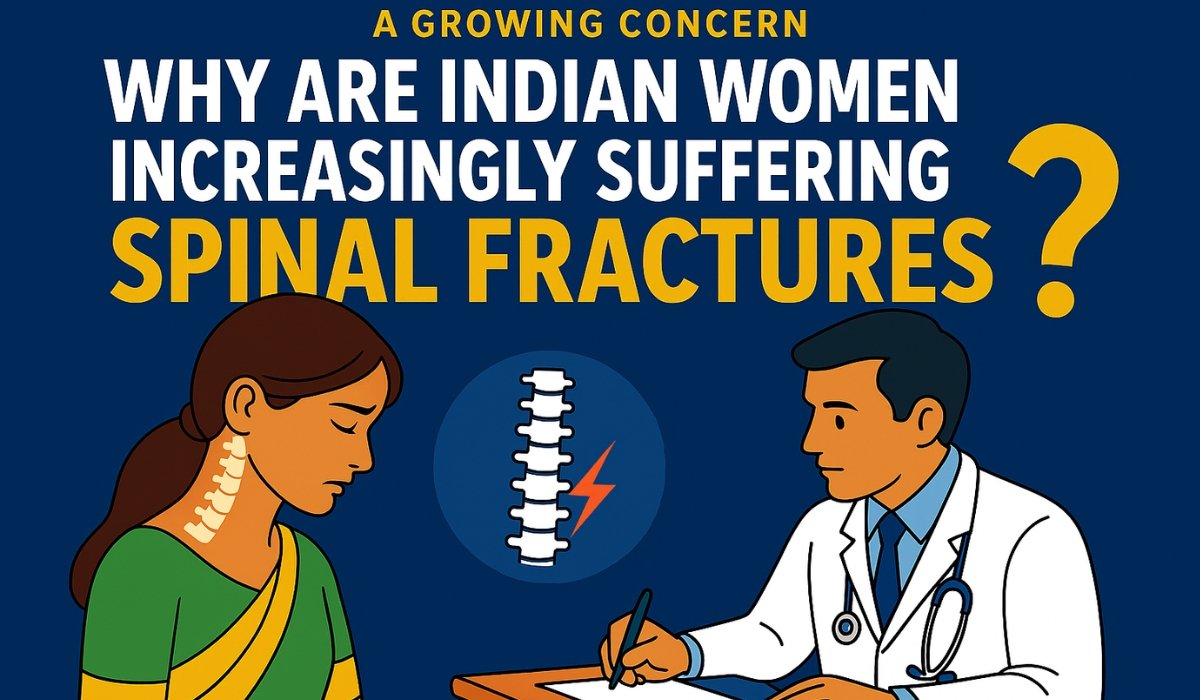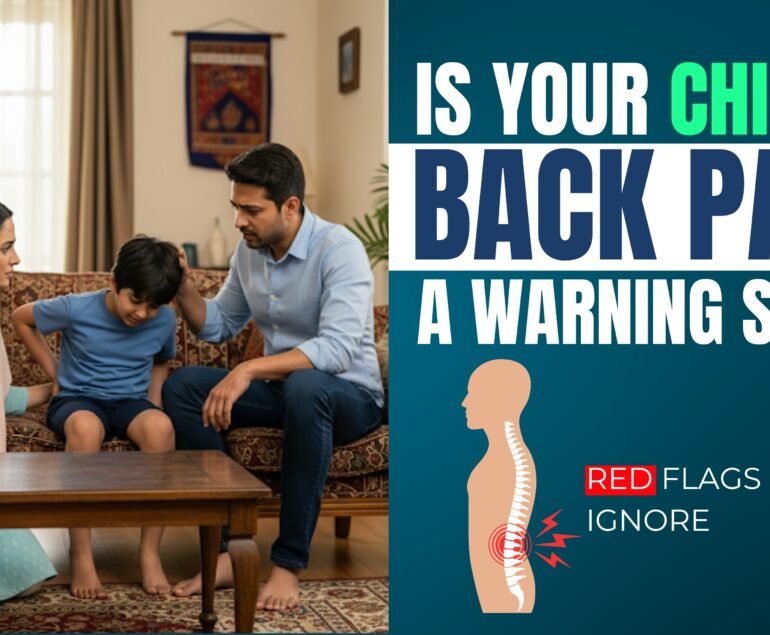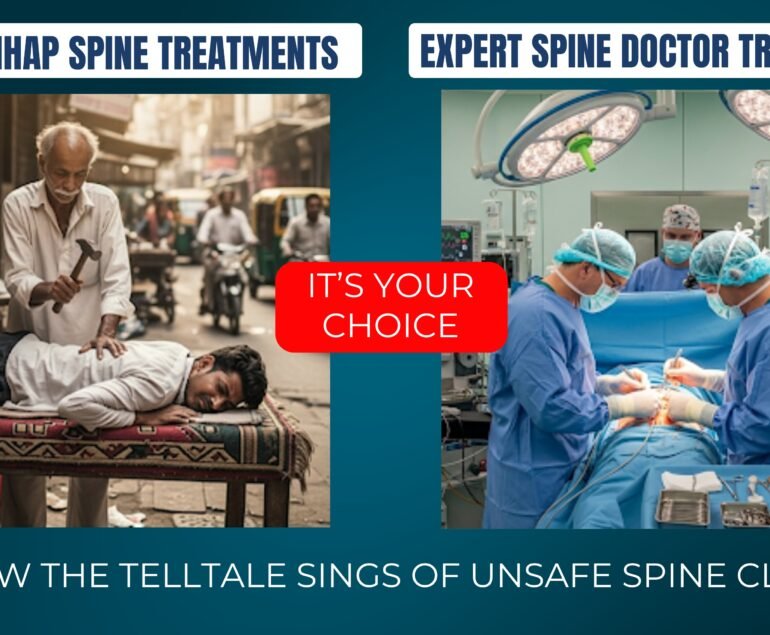A Growing Concern: Why Are Indian Women Increasingly Suffering Spinal Fractures?
Osteoporosis is a ‘silent disease’ that weakens bones without obvious symptoms until a bone fracture occurs. Unfortunately, Indian women are especially vulnerable, particularly when it comes to Osteoporotic Spine fractures. These aren’t just painful; they can lead to chronic disability, stooped posture, height loss, neurological deficits, and even breathing problems in advanced cases.
Let’s explore why Indian women face an increasingly higher risk of osteoporotic spine fractures, and what can be done to prevent them.
What Is an Osteoporotic Spine Fracture?
An Osteoporotic Spine Fracture occurs when bones become markedly weak that even a trivial fall (fall from standing height or a bed/chair) or minor strain (like forward bending and lifting) can cause them to break. In the spine, this often results in Vertebral Compression Fractures, where the bones of the spine collapse.
These can happen suddenly or gradually, sometimes without even a fall or injury.
Why Indian Women Are at Greater Risk
1. Late Diagnosis & Lack of Awareness
Most women don’t realise they have osteoporosis until a fracture occurs. Bone health is rarely discussed in routine health checkups, especially before or after menopause.
- Women ignore early symptoms like back pain or loss of height
- Cultural focus is often more on family health than personal health
- Lack of awareness amongst healthcare professionals
- Lack of standardised diagnostic and treatment algorithms
- Poor accessibility to healthcare resources
- Cultural and societal taboos and misconceptions
2. Calcium & Vitamin D Deficiency
A large percentage of Indian women are deficient in
- Calcium (due to low dairy intake or poor absorption)
- Vitamin D (due to genetic vulnerability, indoor lifestyle, or poor nutrition)
These deficiencies contribute to reduced bone density, increasing fracture risk. However, Calcium and Vitamin D are neither independently the cause nor the treatment for Osteoporosis.
3. Post Menopausal Hormonal Changes
Estrogen plays a major role in maintaining bone strength. After menopause, estrogen levels drop rapidly, causing accelerated bone loss.
In India, menopause often goes unmanaged.
- Younger age of menopause
- Women are not counselled about bone health
- Hormonal therapy is rarely discussed
- Bone strengthening is not prioritised via diet or exercise
4. Poor Nutrition & Obesity/ Low Body Weight
Traditional Indian diets in some regions are
- Low in Protein (Especially in Vegetarian Diets)
- High in Refined Carbohydrates, Oil and Sugar
- Micronutrient Deficiencies
- Overcooking and Nutrient Loss
- Calcium and Vitamin D Deficiency
Both Obesity/ overweight and Low body weight are risk factors for osteoporosis, the former more common amongst urban women and the latter common among rural and older women.
5. Lack of Strengthening and Weight-training Exercises
Physical activity is crucial for healthy bones. However,
- Many women experience reduced physical activity with advancing age
- Walking, strength training, or endurance activities are not part of the routine.
. - A sedentary lifestyle further weakens bones and muscles.
6. Coexisting Multiple Illnesses
- Diabetes
- Autoimmune conditions like Hypothyroidism
- Inflammatory conditions like Rheumatoid Arthritis
- Malignancies
- Medications like corticosteroids, anti-epileptics, etc.
Presence of multiple comorbidities, including but not limited to the ones listed above, increases the risk of osteoporosis as well as results in early onset of osteoporosis, making its management more challenging
Warning Signs of Spinal Osteoporotic Fractures
Don’t ignore these red flags
- Sudden onset of back pain following a trivial injury or even without injury
- Progressive loss of height
- Hunched or stooped posture
- Difficulty sitting/ standing up straight
- Progressive lack of strength or pain in the back
- Generalised body ache/fatigue with multiple joint pains
If you experience these, especially after 50, see a Spine specialist or an Orthopaedic doctor immediately.
Prevention: What Indian Women Can Do
1. Screen Early
- If you are a post-menopausal woman, consult a specialist even if there are no symptoms.
- Don’t ignore the red flag signs.
- If you are suffering from multiple comorbidities or are on various medications
- If there’s a family history of fractures or osteoporosis, start earlier
2. Boost Nutrition
- Calcium-rich foods: paneer, leafy greens, ragi, almonds, fenugreek seeds, supplements
- Vitamin D: sunlight exposure, fortified foods, supplements
- Protein: pulses, eggs, chicken, tofu, soybean
3. Exercise Regularly
- Brisk walking, light strength training, yoga, and weight-bearing exercises
- Avoid sitting for long hours.
4. Consult a Specialist
If you’ve had a fracture or are post menopausal, or have a family history of osteoporosis
- Discuss the management to improve and maintain the bone density
- Understand the Lifestyle modifications and supportive part of the treatment
- Understand the importance and role of bone-building medications when needed
- Discuss the role of Calcium and Vitamin D supplementation
- Avoid Jholachhap treatments or random massages
Special Note for Women Over 50
Bone loss starts silently; don’t wait for a fracture to take action. Indian women deserve better bone health and active ageing.
👩⚕️Postmenopausal women lose bone faster — early screening is key.
🚶♀️ Weight-bearing exercise helps build bones — not just muscles.
🪑 Loss of height or a stooped back? Think spine fracture.
❌ Spinal fractures can happen without a fall or injury.
🔗 Need expert guidance for bone and spine health? Visit Dr. Archit Goyal for consultation, diagnosis, and personalised care.



